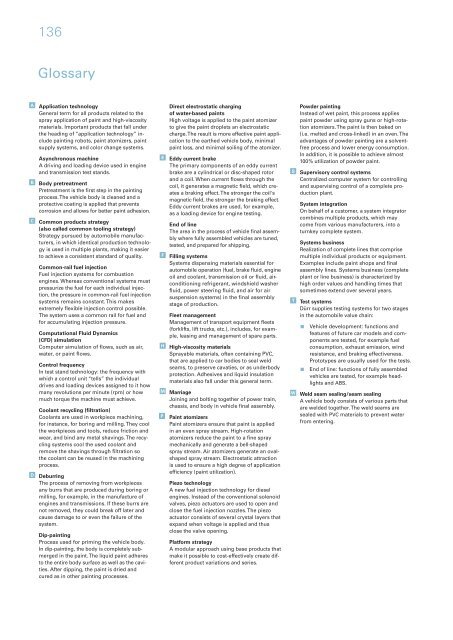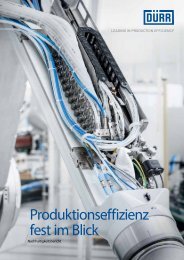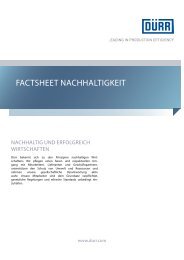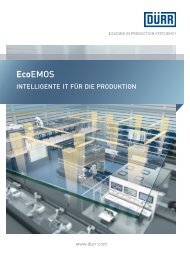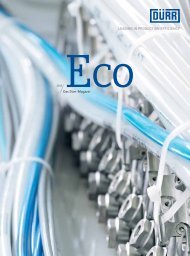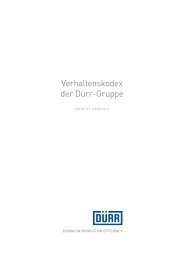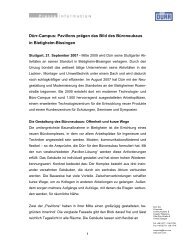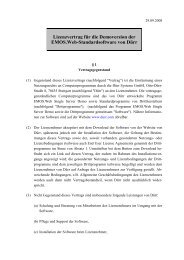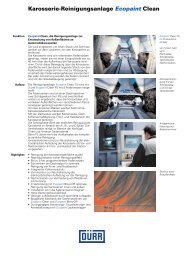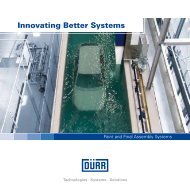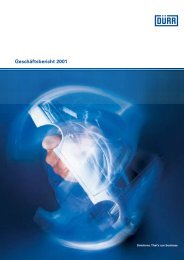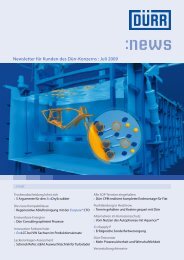Technologies · Systems · Solutions - Dürr
Technologies · Systems · Solutions - Dürr
Technologies · Systems · Solutions - Dürr
Create successful ePaper yourself
Turn your PDF publications into a flip-book with our unique Google optimized e-Paper software.
B<br />
C<br />
D<br />
136<br />
Glossary<br />
A Direct electrostatic charging<br />
Application technology<br />
General term for all products related to the<br />
spray application of paint and high-viscosity<br />
materials. Important products that fall under<br />
the heading of “application technology” include<br />
painting robots, paint atomizers, paint<br />
supply systems, and color change systems.<br />
Asynchronous machine<br />
A driving and loading device used in engine<br />
and transmission test stands.<br />
Body pretreatment<br />
Pretreatment is the first step in the painting<br />
process. The vehicle body is cleaned and a<br />
protective coating is applied that prevents<br />
corrosion and allows for better paint adhesion.<br />
Common products strategy<br />
(also called common tooling strategy)<br />
Strategy pursued by automobile manufacturers,<br />
in which identical production technology<br />
is used in multiple plants, making it easier<br />
to achieve a consistent standard of quality.<br />
Common-rail fuel injection<br />
Fuel injection systems for combustion<br />
engines. Whereas conventional systems must<br />
pressurize the fuel for each individual injection,<br />
the pressure in common-rail fuel injection<br />
systems remains constant. This makes<br />
extremely flexible injection control possible.<br />
The system uses a common rail for fuel and<br />
for accumulating injection pressure.<br />
Computational Fluid Dynamics<br />
(CFD) simulation<br />
Computer simulation of flows, such as air,<br />
water, or paint flows.<br />
Control frequency<br />
In test stand technology: the frequency with<br />
which a control unit “tells” the individual<br />
drives and loading devices assigned to it how<br />
many revolutions per minute (rpm) or how<br />
much torque the machine must achieve.<br />
Coolant recycling (filtration)<br />
Coolants are used in workpiece machining,<br />
for instance, for boring and milling. They cool<br />
the workpieces and tools, reduce friction and<br />
wear, and bind any metal shavings. The recycling<br />
systems cool the used coolant and<br />
remove the shavings through filtration so<br />
the coolant can be reused in the machining<br />
process.<br />
Deburring<br />
The process of removing from workpieces<br />
any burrs that are produced during boring or<br />
milling, for example, in the manufacture of<br />
engines and transmissions. If these burrs are<br />
not removed, they could break off later and<br />
cause damage to or even the failure of the<br />
system.<br />
Dip-painting<br />
Process used for priming the vehicle body.<br />
In dip-painting, the body is completely submerged<br />
in the paint. The liquid paint adheres<br />
to the entire body surface as well as the cavities.<br />
After dipping, the paint is dried and<br />
cured as in other painting processes.<br />
E<br />
F<br />
H<br />
M<br />
P<br />
of water-based paints<br />
High voltage is applied to the paint atomizer<br />
to give the paint droplets an electrostatic<br />
charge. The result is more effective paint application<br />
to the earthed vehicle body, minimal<br />
paint loss, and minimal soiling of the atomizer.<br />
Eddy current brake<br />
The primary components of an eddy current<br />
brake are a cylindrical or disc-shaped rotor<br />
and a coil. When current flows through the<br />
coil, it generates a magnetic field, which creates<br />
a braking effect. The stronger the coil's<br />
magnetic field, the stronger the braking effect.<br />
Eddy current brakes are used, for example,<br />
as a loading device for engine testing.<br />
End of line<br />
The area in the process of vehicle final assembly<br />
where fully assembled vehicles are tuned,<br />
tested, and prepared for shipping.<br />
Filling systems<br />
<strong>Systems</strong> dispensing materials essential for<br />
automobile operation (fuel, brake fluid, engine<br />
oil and coolant, transmission oil or fluid, airconditioning<br />
refrigerant, windshield washer<br />
fluid, power steering fluid, and air for air<br />
suspension systems) in the final assembly<br />
stage of production.<br />
Fleet management<br />
Management of transport equipment fleets<br />
(forklifts, lift trucks, etc.), includes, for example,<br />
leasing and management of spare parts.<br />
High-viscosity materials<br />
Sprayable materials, often containing PVC,<br />
that are applied to car bodies to seal weld<br />
seams, to preserve cavaties, or as underbody<br />
protection. Adhesives and liquid insulation<br />
materials also fall under this general term.<br />
Marriage<br />
Joining and bolting together of power train,<br />
chassis, and body in vehicle final assembly.<br />
Paint atomizers<br />
Paint atomizers ensure that paint is applied<br />
in an even spray stream. High-rotation<br />
atomizers reduce the paint to a fine spray<br />
mechanically and generate a bell-shaped<br />
spray stream. Air atomizers generate an ovalshaped<br />
spray stream. Electrostatic attraction<br />
is used to ensure a high degree of application<br />
efficiency (paint utilization).<br />
Piezo technology<br />
A new fuel injection technology for diesel<br />
engines. Instead of the conventional solenoid<br />
valves, piezo actuators are used to open and<br />
close the fuel injection nozzles. The piezo<br />
actuator consists of several crystal layers that<br />
expand when voltage is applied and thus<br />
close the valve opening.<br />
Platform strategy<br />
A modular approach using base products that<br />
make it possible to cost-effectively create different<br />
product variations and series.<br />
S<br />
T<br />
W<br />
Powder painting<br />
Instead of wet paint, this process applies<br />
paint powder using spray guns or high-rotation<br />
atomizers. The paint is then baked on<br />
(i.e. melted and cross-linked) in an oven. The<br />
advantages of powder painting are a solventfree<br />
process and lower energy consumption.<br />
In addition, it is possible to achieve almost<br />
100% utilization of powder paint.<br />
Supervisory control systems<br />
Centralized computer system for controlling<br />
and supervising control of a complete production<br />
plant.<br />
System integration<br />
On behalf of a customer, a system integrator<br />
combines multiple products, which may<br />
come from various manufacturers, into a<br />
turnkey complete system.<br />
<strong>Systems</strong> business<br />
Realization of complete lines that comprise<br />
multiple individual products or equipment.<br />
Examples include paint shops and final<br />
assembly lines. <strong>Systems</strong> business (complete<br />
plant or line business) is characterized by<br />
high order values and handling times that<br />
sometimes extend over several years.<br />
Test systems<br />
<strong>Dürr</strong> supplies testing systems for two stages<br />
in the automobile value chain:<br />
Vehicle development: functions and<br />
features of future car models and components<br />
are tested, for example fuel<br />
consumption, exhaust emission, wind<br />
resistance, and braking effectiveness.<br />
Prototypes are usually used for the tests.<br />
End of line: functions of fully assembled<br />
vehicles are tested, for example headlights<br />
and ABS.<br />
Weld seam sealing/seam sealing<br />
A vehicle body consists of various parts that<br />
are welded together. The weld seams are<br />
sealed with PVC materials to prevent water<br />
from entering.


